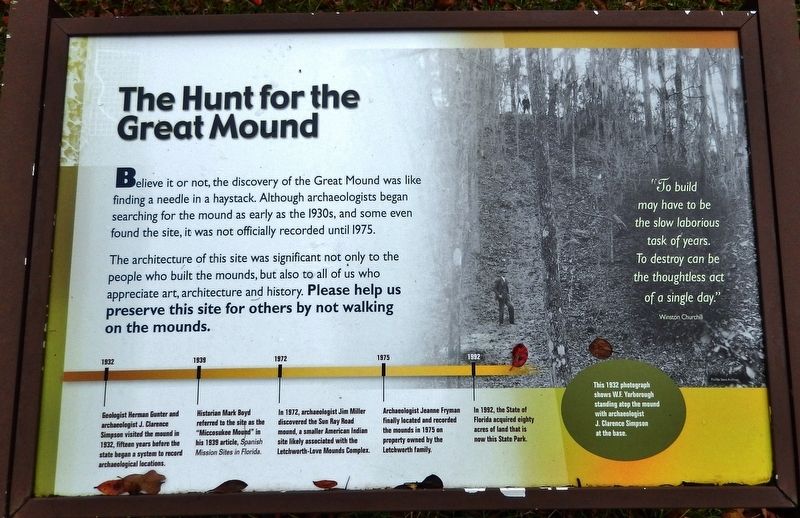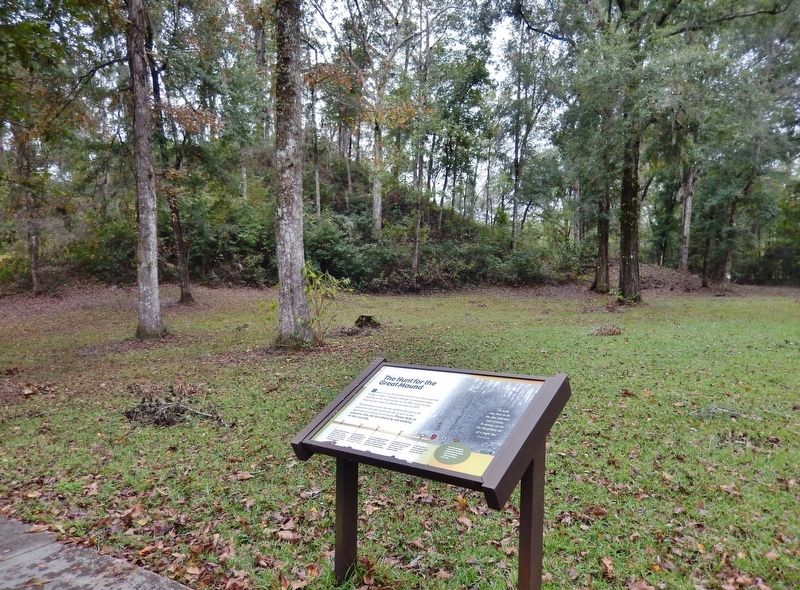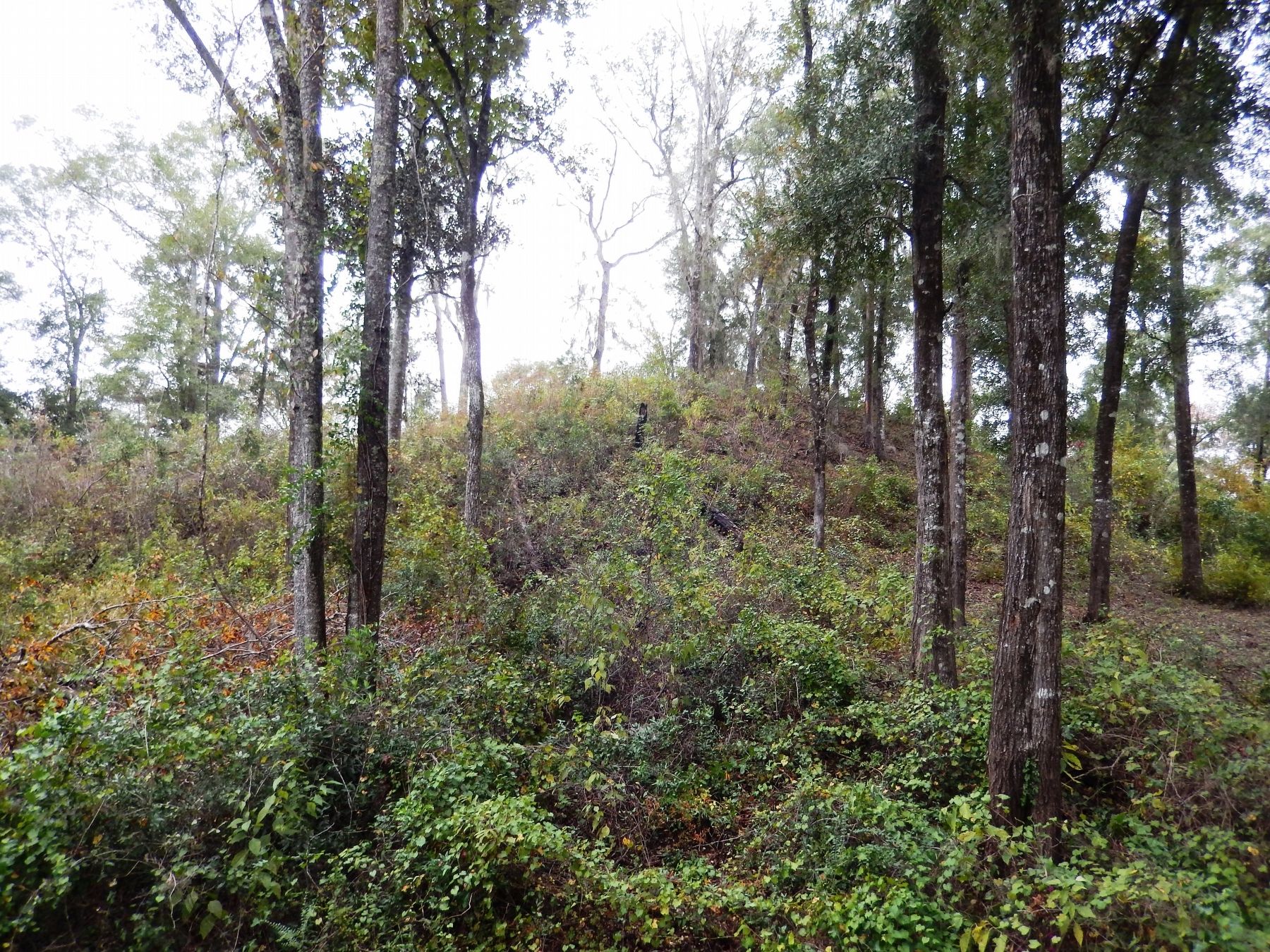Near Monticello in Jefferson County, Florida — The American South (South Atlantic)
The Hunt for the Great Mound
The architecture of this site was significant not only to the people who built the mounds, but also to all of us who appreciate art, architecture and history. Please help us preserve this site for others by not walking on the mounds.
”To build may have to be the slow laborious task of years. To destroy can be the thoughtless act of a single day.”
—Winston Churchill
• 1932 Geologist Herman Gunter and archaeologist J. Clarence Simpson visited the mound in 1932, fifteen years before the state began a system to record archaeological locations.
• 1939 Historian Mark Boyd referred to the site as the "Miccosukee Mound" in his 1939 article, Spanish Mission Sites in Florida.
• 1972 In 1972, archaeologist Jim Miller discovered the Sun Ray Road mound, a smaller American Indian site likely associated with the Letchworth-Love Mounds Complex.
• 1975 Archaeologist Jeanne Fryman finally located and recorded the mounds in 1975 on property owned by the Letchworth family.
• 1992 In 1992, the State of Florida acquired eighty acres of land that is now this State Park.
(photo caption)
This 1932 photograph shows W.F. Yarborough standing atop the mound with archaeologist J. Clarence Simpson at the base.
Erected by Letchworth-Love Mounds Archaeological State Park.
Topics. This historical marker is listed in these topic lists: Anthropology & Archaeology • Architecture • Native Americans. A significant historical year for this entry is 1975.
Location. 30° 31.158′ N, 83° 59.483′ W. Marker is near Monticello, Florida, in Jefferson County. Marker can be reached from Sunray Road, 0.6 miles south of Mahan Drive (U.S. 90), on the right when traveling south. Marker is located along the interpretive trail at Letchworth-Love Mounds Archaeological State Park, overlooking the Great Mound. Touch for map. Marker is at or near this postal address: 4500 Sunray Road South, Monticello FL 32344, United States of America. Touch for directions.
Other nearby markers. At least 8 other markers are within 7 miles of this marker, measured as the crow flies. Lasting Impressions (within shouting distance of this marker); Digging Deeper (about 300 feet away, measured in a direct line); The Lay of the Land (about 300 feet away); Letchworth-Love Mounds Archaeological State Park (about 400 feet away); Miccosukee United Methodist Church
(approx. 5.9 miles away); Village of Miccosukee (approx. 6 miles away); Constant Attack (approx. 6.9 miles away); Confederate Memorial (approx. 6.9 miles away). Touch for a list and map of all markers in Monticello.
Related markers. Click here for a list of markers that are related to this marker. Letchworth-Love Mounds Archaeological State Park
Also see . . .
1. Letchworth-Love Mounds Archaeological State Park (Wikipedia). Although the mound now has trees and underbrush growing from it, when originally built, such earthwork mounds were typically clear of vegetation, with smooth prepared sides. Many workers had to bring soils by basket to build the mound. The builders used their knowledge to combine a variety of soils and shells for stability, and usually finished the top and sides with clay. The mound likely rose from flat plazas which were intentionally leveled. (Submitted on July 22, 2020, by Cosmos Mariner of Cape Canaveral, Florida.)
2. Letchworth-Love Mounds Archaeological State Park. At 46 feet, this is Florida's tallest Native American ceremonial earthwork mound, which was built between 1100 and 1800 years ago, however artifacts and evidence of nearly 12,000 years
of human habitation have been found at this site. (Submitted on July 22, 2020, by Cosmos Mariner of Cape Canaveral, Florida.)
Credits. This page was last revised on July 22, 2020. It was originally submitted on July 21, 2020, by Cosmos Mariner of Cape Canaveral, Florida. This page has been viewed 264 times since then and 11 times this year. Photos: 1. submitted on July 21, 2020, by Cosmos Mariner of Cape Canaveral, Florida. 2, 3. submitted on July 22, 2020, by Cosmos Mariner of Cape Canaveral, Florida.


